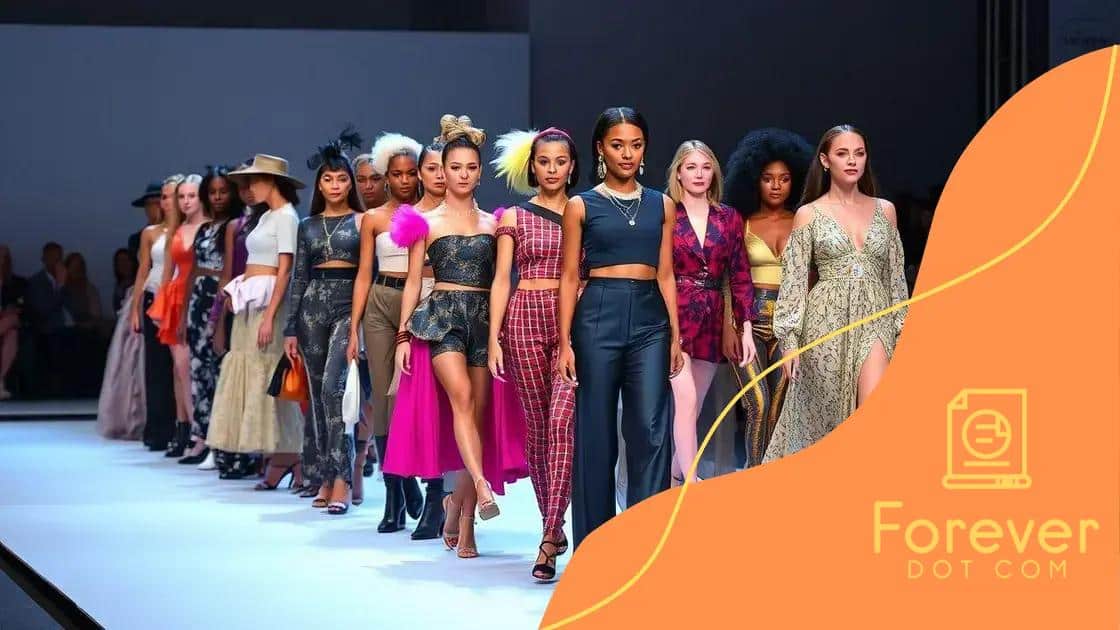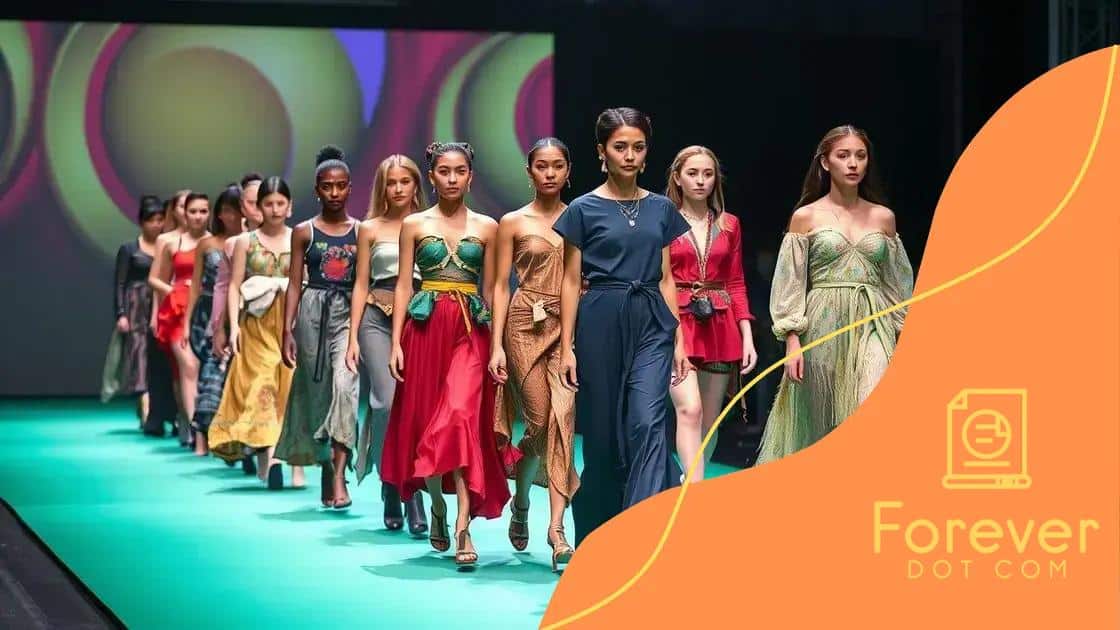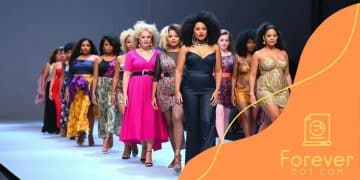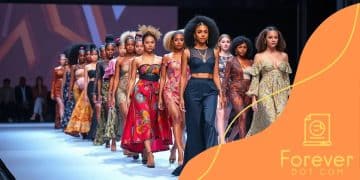Models breaking barriers in global fashion shows

Models breaking barriers in global fashion shows highlight the industry’s shift towards inclusivity and diversity, showcasing various body types, cultures, and innovative designs that challenge traditional norms.
Models breaking barriers in global fashion shows is a phenomenon reshaping the fashion landscape. Have you noticed how these diverse representations challenge old norms? Let’s dive into what this means for the industry.
The rise of diverse models in fashion
The rise of diverse models in fashion is changing the way we view beauty. For years, the industry has focused on a narrow representation of models, but now, we see a vibrant mix of ethnicities, body types, and ages on the runway. This shift not only reflects society’s diversity but also encourages the acceptance of different standards of beauty.
Understanding Diversity in Fashion
Diversity in fashion means more than just different faces on the runway. It signifies a shift towards inclusion and representation. When diverse models showcase designs, they tell stories that resonate with various audiences. However, it is important for brands to not only include diverse models but also understand the narratives they bring.
The Benefits of Diverse Representation
- Promotes a broader definition of beauty.
- Enables connection with a wider audience.
- Encourages self-expression among different communities.
- Inspires young individuals from diverse backgrounds.
As the variety of models increases, brands are re-evaluating their marketing strategies. By embracing diversity, they improve their connection with consumers. Moreover, when people see models that look like them, it boosts their confidence and self-esteem.
Companies that take the initiative to promote a more inclusive atmosphere are often met with positive responses. Audiences appreciate brands that reflect real life. This can lead to loyalty, as consumers seek to support companies that share their values.
Challenges on the Journey
Despite the progress, challenges still exist. Many brands face criticism for tokenism or superficial engagement with diversity. A deeper understanding of culture and sensitivity is essential in curating a genuinely diverse representation. This ensures that the models’ voices are acknowledged and valued.
As we look to the future, it is clear that the trend of diverse models is not just a passing phase. The fashion industry is evolving, driven by the demand for authenticity and inclusivity. The stories shared through diverse models will continue to shape the narratives of the fashion world.
Impact of representation on consumers
The impact of representation on consumers is significant in today’s fashion industry. When people see models that look like them, it creates a sense of belonging and validation. This visibility fosters acceptance of one’s own identity and encourages self-confidence.
Importance of Representation
Representation goes beyond just appearances; it influences how individuals perceive their place in society. Having diverse models on the runway allows consumers to feel recognized and valued. This inclusivity is vital for building brand loyalty.
Building Emotional Connections
- Consumers relate better to brands that showcase diversity.
- Models representing various cultures promote understanding.
- Emotional connections drive purchasing decisions.
- Diverse campaigns can attract a broader audience.
When consumers feel represented, they are more likely to engage with and support brands. This emotional connection can lead to increased trust and loyalty. In this ever-evolving industry, understanding the power of representation helps brands connect deeply with their audience.
In recent years, many brands have recognized this shift and adapted their marketing strategies accordingly. They are moving away from traditional ideas and embracing a more inclusive approach. However, it is important for brands to ensure that their representation efforts are authentic and not just a marketing gimmick.
Consumers as Activists
Today’s consumers are increasingly becoming activists. They demand more from brands regarding diversity and representation. When they notice a lack of inclusivity, they voice their concerns on social media, influencing brands to change. This consumer activism highlights the importance of representing different identities and cultures in fashion.
Innovative designs that challenge the status quo

Innovative designs that challenge the status quo are reshaping the fashion industry. Designers are stepping outside traditional norms to create unique styles that reflect modern society. These bold choices often embrace sustainability, inclusivity, and cultural influences.
Embracing Sustainability
Many designers are now focusing on creating sustainable fashion. This means using eco-friendly materials and processes that reduce waste. By doing this, they not only cater to environmentally conscious consumers but also set new industry standards.
Cultural Influences
- Integrating diverse cultural elements in fashion designs.
- Celebrating traditions while creating contemporary styles.
- Highlighting global craftsmanship and artistry.
- Fostering connections between cultures through fashion.
Innovative designs often reflect a blend of various cultural influences. This fusion leads to fashion that is not only stylish but also meaningful. When designers incorporate elements from different cultures, they create pieces that tell a story and invite dialogue.
Furthermore, many brands are interestingly exploring new technologies in their designs. For instance, 3D printing is becoming more common, allowing designers to create complex structures and shapes. This technology encourages creativity and pushes the boundaries of what is possible in fashion.
Inclusivity in Design
Innovation in fashion also means making clothing accessible to everyone. Designers are beginning to create pieces that cater to a wider range of body types and sizes. By doing so, they challenge traditional sizing norms and promote a more inclusive industry.
As we see these innovative designs emerge, it’s apparent that the fashion world is evolving quickly. The boldness of these choices encourages consumers to rethink their perceptions of beauty and style.
How brands are adapting to changing norms
Brands are adapting to changing norms in the fashion industry to stay relevant. As consumers demand more inclusivity and sustainability, companies are evolving their practices. This shift is essential for maintaining a loyal customer base.
Shifting Marketing Strategies
To meet the expectations of a diverse audience, brands are revising their marketing strategies. They are working to include varied representations in their campaigns. Showing models of different shapes, sizes, and backgrounds creates a more authentic connection with consumers. As this happens, many brands also engage with social movements to show their support.
Leveraging Technology
- Using social media to highlight diverse voices.
- Implementing virtual fitting rooms for wider accessibility.
- Creating campaigns that focus on sustainable practices.
- Engaging in real-time feedback to improve products.
Companies are also adopting technology to reach their audience effectively. With platforms like Instagram and TikTok, brands can showcase their products directly to consumers. This approach fosters transparency, allowing consumers to feel more involved in the brand’s journey.
Moreover, the focus on sustainability is pushing brands to explore eco-friendly materials and ethical labor practices. More companies are committing to transparency regarding their production processes. This commitment not only attracts eco-conscious consumers but also promotes a broader cultural shift in the industry.
Consumer-Centric Approach
As brands reconsider their approaches, they are placing consumers at the center of their decisions. Listening to feedback and involving customers in product development is becoming more common. This shift allows companies to cater directly to the preferences and needs of their audience, ensuring greater satisfaction.
In essence, adapting to changing norms is no longer an option but a necessity in the fashion world. Brands that succeed in this regard are those that embrace diversity and innovation as core values.
Future trends in inclusive fashion
Future trends in inclusive fashion are becoming more pronounced as the industry evolves. As consumers demand greater representation, brands are finding new ways to meet these expectations. The future looks promising with a focus on accessibility, sustainability, and diversity.
Emphasis on Accessibility
One primary trend is the push for accessibility in clothing. Brands are starting to design garments that accommodate a variety of body types and mobility challenges. This means creating adaptive clothing that is stylish yet functional for individuals with disabilities.
Use of Technology
- Online platforms for virtual fittings.
- 3D printing for customized clothing.
- Wearable technology integrated into fashion.
- AI-driven styling recommendations.
Technology plays a crucial role in this evolution. Innovations like virtual reality and augmented reality are set to revolutionize how consumers shop. These technologies allow customers to visualize how clothes will look on them without physically trying them on, making the shopping experience more inclusive.
Another trend is the rise of gender-neutral fashion. More brands are blurring the lines between traditional menswear and womenswear, offering collections that are designed for anyone, regardless of gender. This shift is redefining the concept of fashion and making it more accessible to all.
Sustainability and Ethics
Moreover, sustainability remains a core focus. Brands are increasingly creating garments with eco-friendly materials and sustainable practices. By being mindful of their environmental impact, companies not only appeal to eco-conscious consumers but also promote a brighter future for the planet.
Beyond sustainability, the notion of ethical production is gaining traction. Consumers want to know that their clothes are made under fair labor conditions. As a result, brands are being held accountable, fostering a culture of responsibility and transparency in fashion.
These strides towards an inclusive and sustainable future in fashion illustrate the industry’s willingness to adapt. By embracing these trends, brands can create a more equitable landscape for everyone.
FAQ – Frequently Asked Questions about Inclusive Fashion
What is inclusive fashion?
Inclusive fashion refers to clothing designs that accommodate all body types, sizes, and identities, ensuring everyone can find stylish and functional attire.
How are brands promoting sustainability in fashion?
Brands are adopting eco-friendly materials and sustainable production practices to reduce their environmental impact and appeal to environmentally conscious consumers.
What role does technology play in the future of fashion?
Technology enables innovations like virtual try-ons, 3D printing, and AI-driven recommendations, enhancing the shopping experience and making it more inclusive.
How can consumers influence fashion brands?
Consumers can influence brands by providing feedback, supporting inclusive practices, and choosing to buy from companies that align with their values.






